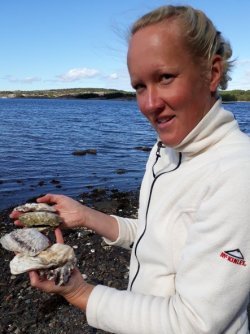How will the ongoing environmental change affect seabed microbes?
There would be no life on our planet without the microscopic organisms known as microbes. The environmental change resulting from human activity has altered the biodiversity and functioning of microbial communities, but the long-ranging impacts of the changes are not yet known. Now, research is being carried out to enhance our understanding and enable us to prepare for and prevent harmful impacts.Published: 3.11.2022
Writer: Leena Virta
Editing: Viestintätoimisto Jokiranta Oy
Image: Leena Virta
The seabed is full of microscopic life in all areas within the reach of light. Microbial communities are comprised of a wide range of living organisms, such as algae, bacteria and fungi, which play a number of roles in the ecosystems.
The ongoing environmental change resulting from human activity affects all living organisms on Earth and has already caused a wave of extinctions. What would happen if the microbes living in or on the seabed died out?
As a consequence of microbial extinction, the marine food chain would collapse. Animals that live on the bottom of the sea, also known as benthic fauna, would no longer have anything to eat, so they would die out. Then, the fish that feed on benthic animals would no longer have anything to eat, so extinction would be their fate as well. The chain of extinctions would be endless.
Along with the loss of microbes, the nutrient cycle would come to a halt. Many of the benthic microbes, such as bacteria and fungi, break down dead or decaying organic matter, whereby the nutrients bound to the matter are released back to the nutrient cycle. If these microbes were lost, the organisms in the photosynthesis would be deprived of the nutrients necessary for their growth.
The seabed microbes are much more efficient in recycling and storing carbon as compared to the plants growing on land. In fact, many of the marine bottom zones serve as carbons sinks, thus curbing climate change. If these microbes died out, the seabed would turn into carbon sources and climate change would accelerate dramatically.
How is climate change altering microbial communities?
All life both in seas and on land is dependent on microbes. Could climate change lead to microbial extinction? The answer is ‘no’. Microbes are able to live in places where no other living organism would survive. They can withstand extreme environments ranging from hot springs to the Dead Sea and will survive the climate change, too. The climate change can, however, affect the biodiversity and functioning of microbial communities, which may have far-reaching impacts. For the time being, we do not know much about these alterations, so we can only make educated guesses.
For example, along with the warming of seawater, the benthic microbial communities predominated by diatoms may become predominated by cyanobacteria, also known as blue algae. That would be bad news for the benthic fauna feeding on the nutrient-rich diatoms. It might also be bad news in terms of climate change: while diatoms mostly produce oxygen, cyanobacteria contribute to the production of greenhouse gases, such as methane.
Guessing is, however, not a proper way to prepare for or prevent future changes. Therefore, it is vital for us to explore what actually is happening to the benthic microbes along with the advancing climate change.
Bathroom tiles are useful for research purposes
Within the Baltic Sea, the most important changes related to global warming include the rising temperature and declining salinity. In my research, I focus on exploring their impact on the biodiversity and functioning of the microbial communities living in the bottom zone of the Baltic Sea. Bathroom tiles are of convenient size, easy to move and suitable for sampling purposes, so I’m using them as growing platforms for microbes.
First, the tiles are placed in the sea for six weeks to allow microbial communities to grow on them. Second, the tiles are moved into a total of 10 experimental aquariums known as mesocosms. The salinity and temperature of water varies from one mesocosm to another. During a 6-week experiment, I will study the effects of rising temperature and declining salinity on the biodiversity of microbial communities, as well as their carbon recycling and storing capacity, which is an essential feature in terms of climate change. Also, I will study whether or not the microbial communities produce greenhouse gases.
In short, the aim is to clarify in what ways climate change affects the benthic microbes and, vice versa, how the microbes affect climate change. My research project is one of the first studies exploring the associations between the benthic microbes and climate change – the results may be surprising!

PhD Leena Virta works as a Postdoctoral Researcher at Tvärminne Zoological Station of the University of Helsinki and is currently exploring the effects of climate and environmental changes on the microorganisms living on or in the bottom of the Baltic Sea. Virta earned her PhD in 2020 from the Doctoral Programme in Geosciences. For her doctoral thesis, she studied the impact of the diversity patterns of benthic diatoms on the ecosystems’ biomass producing capacity, along with the temporal and spatial variation in biodiversity in different habitats, as well as diversity-affecting environmental factors.
